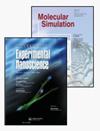Rapid screening of gas solubility in ionic liquids using biased particle insertions with pre-sampled liquid trajectories
IF 2
4区 化学
Q4 CHEMISTRY, PHYSICAL
引用次数: 0
Abstract
ABSTRACTWe present an efficient, general-purpose variant of the Widom test particle insertion method for computing chemical potentials of gaseous solutes in fluids or porous solids. The method is implemented in the Monte Carlo molecular simulation engine Cassandra, but receiving phase configurations are independent of this process and may be pre-sampled by other molecular simulation engines such as molecular dynamics codes. Efficiency enhancements present in this method include configurational biasing and accelerated atomic overlap detection. When applied to the estimation of Henry's law constants of atomistic difluoromethane and pentafluoroethane in ionic liquids, the accelerated overlap detection results in a speedup of more than an order of magnitude compared to conventional methods without sacrificing accuracy. We found good agreement between this method and Hamiltonian replica exchange (HREX) for Henry's law constant and absorption isotherm estimation. This embarrassingly parallel method is especially well suited for screening Henry's law constants of many small gases in the same solvents, since a liquid trajectory can be reused for as many solutes as desired.KEYWORDS: Free energycell listionic liquidsWidom insertionshydrofluorocarbons AcknowledgmentsComputing resources were provided by the Center for Research Computing (CRC) at the University of Notre Dame. We thank Dr. Ryan DeFever for providing us with HREX results.Disclosure statementNo potential conflict of interest was reported by the author(s).Associated contentExample input files for LAMMPS and Cassandra simulations like those performed for this work are provided at https://github.com/MaginnGroup/widom_IL_examples.The repository for Cassandra can be found at https://github.com/MaginnGroup/Cassandra.Additional informationFundingThe authors are thankful for the financial support from the National Science Foundation via grant EFRI DChem: Next-generation Low Global Warming Refrigerants, Award No. 2029354.离子液体中气体溶解度的快速筛选使用预采样液体轨迹的偏置粒子插入
摘要我们提出了一种高效、通用的Widom测试粒子插入方法,用于计算流体或多孔固体中气态溶质的化学势。该方法在Monte Carlo分子模拟引擎Cassandra中实现,但接收相配置独立于此过程,并且可以通过其他分子模拟引擎(如分子动力学代码)进行预采样。该方法的效率提高包括构型偏置和加速原子重叠检测。当应用于离子液体中原子二氟甲烷和五氟乙烷的亨利定律常数的估计时,与传统方法相比,加速的重叠检测结果在不牺牲精度的情况下加速了一个数量级以上。结果表明,该方法与哈密顿复刻交换法(HREX)对亨利定律常数和吸收等温线的估计吻合较好。这种令人尴尬的平行方法特别适合于筛选相同溶剂中许多小气体的亨利定律常数,因为液体轨迹可以重复使用尽可能多的溶质。关键词:自由能,电池,液晶液体,智能插入,氢氟碳化合物,致谢计算资源由圣母大学研究计算中心(CRC)提供。我们感谢Ryan DeFever医生为我们提供HREX结果。披露声明作者未报告潜在的利益冲突。相关内容LAMMPS和Cassandra模拟的示例输入文件,如为这项工作所执行的,可在https://github.com/MaginnGroup/widom_IL_examples.The Cassandra存储库中找到https://github.com/MaginnGroup/Cassandra.Additional informationfunding .作者感谢国家科学基金会通过资助EFRI DChem:下一代低全球变暖制冷剂,奖励号2029354提供的财政支持。
本文章由计算机程序翻译,如有差异,请以英文原文为准。
求助全文
约1分钟内获得全文
求助全文
来源期刊

Molecular Simulation
化学-物理:原子、分子和化学物理
CiteScore
3.80
自引率
9.50%
发文量
128
审稿时长
3.1 months
期刊介绍:
Molecular Simulation covers all aspects of research related to, or of importance to, molecular modelling and simulation.
Molecular Simulation brings together the most significant papers concerned with applications of simulation methods, and original contributions to the development of simulation methodology from biology, biochemistry, chemistry, engineering, materials science, medicine and physics.
The aim is to provide a forum in which cross fertilization between application areas, methodologies, disciplines, as well as academic and industrial researchers can take place and new developments can be encouraged.
Molecular Simulation is of interest to all researchers using or developing simulation methods based on statistical mechanics/quantum mechanics. This includes molecular dynamics (MD, AIMD), Monte Carlo, ab initio methods related to simulation, multiscale and coarse graining methods.
 求助内容:
求助内容: 应助结果提醒方式:
应助结果提醒方式:


